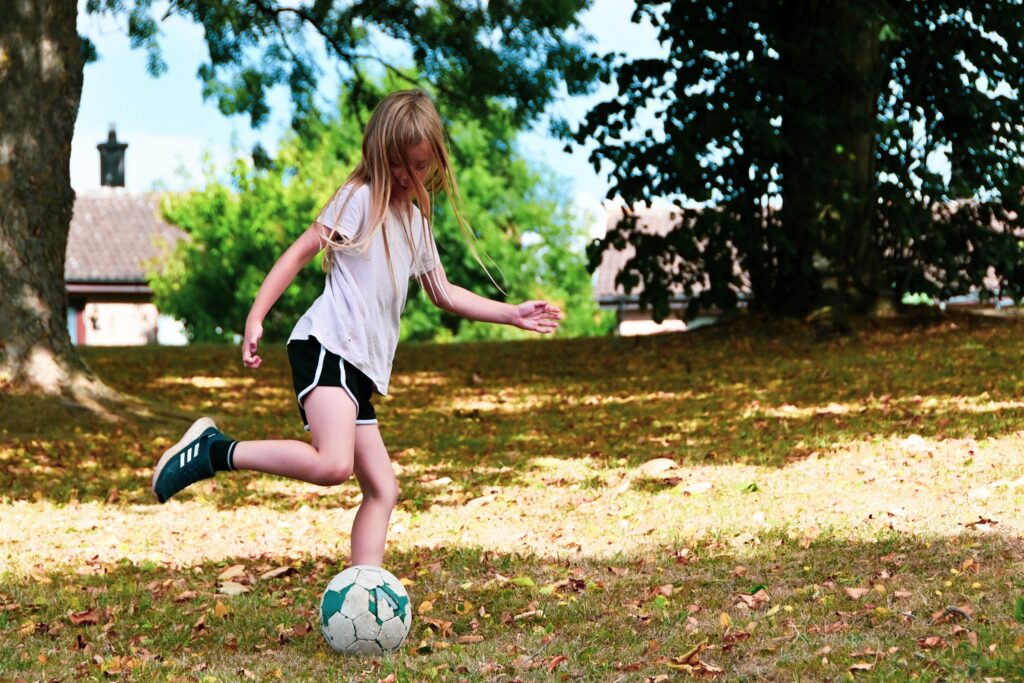Photo by Hello I’m Nik on Unsplash
From a very early age children develop awareness about social categories and groups and learn to categorise themselves and others into these groups. This categorization is assumed to be one of the ways to organise the world and reduce complexity and uncertainty. However, it could also be a basis for stereotypes, prejudices and in-group bias. In-group bias is a tendency for people to favour and give preferential treatment to individuals who belong to the same group as they do, over the ones who belong to different groups.
According to a developmental intergroup theory, human attributes to which children’s attention is drawn are more likely to become a basis for categorization. Examples of practices through which children’s attention can be drawn are explicit labelling, organisation of the environment based on the groups, and social segregation. In the absence of these conditions even perceptually salient attributes might be ignored, such as hair colour for instance. Once the attribute becomes a basis of classification, it might also lead to stereotypes and in-group bias. For example, studies suggest that around the age 2 or 3 children begin to develop their racial and gender identities and by early primary school they hold stereotypes and favour in-group over the outgroup-members.
These stereotypes and in-group biases can have a lot of negative consequences for children. First of all, they can nudge children to act in line with the stereotypes, which might restrict their behavioural repertoires. In the case of gender stereotypes, studies indicate that from early childhood on, children tend to act in line with cultural gender stereotypes in domains like school tasks, sports, and personality. Gender stereotypes are shown to direct different genders towards different roles and activities, and to decrease motivation, involvement and performance of girls in certain domains and those of boys in other domains.
Secondly, children can experience sanctions for not conforming to gender stereotypes or be rejected, bullied, or discriminated against by their peers based on the group membership. One review of the research in the area of gender stereotypes and discrimination has identified different forms of sexism: stereotyping and discrimination against boys related to school behaviour and discipline; stereotyping and discrimination against girls related to science, technology, engineering, and mathematics (STEM) domains; stereotyping and discrimination in sports; peer gender harassment and sexual harassment; and sexualized gender stereotypes. Other studies have shown that girls frequently feel like judged as sexual objects, while sexual harassment can have consequences for both physical and mental health.
Despite these negative consequences parents and caregivers are not always ready to discuss these issues with their children. They sometimes tend to ignore the stereotypes and discrimination that might privilege some groups over others, fearing that these topics could be too complex for children to understand or that talking about them might be harmful for children. However, studies indicate that avoiding these types of conversations with children is not an effective strategy in preventing biases and discrimination.
Even though some studies have documented potential risks of learning about biases related to social groups, like elevating negative emotions in children, increasing out-group mistrust, or strengthening stereotypes and prejudice, a review of risks and benefits in this area has concluded that learning about intergroup biases could still be valuable. Benefits of these talks could be that children learn that stereotypes are a result of environmental factors (e.g. oppression) rather than natural, inborn attributes of members of the groups. Moreover, these types of discussions can teach them to detect, challenge and reject discrimination or improve their self-esteem. Learning about ingroup favouritism and how to attribute negative evaluations from others to biases rather than to inborn or inherent attributes can be particularly important for children who might be targets of stereotypes and discrimination.
Experimental studies and interventions have tested some of the strategies for teaching children about biases and discrimination. Evidence from these studies suggests that explicit conversations about biases and historical and current discrimination can improve their understanding of global issues on inequality and teach them to identify and counter biases. Moreover, discussing explicit strategies for challenging peers’ remarks also seems to have potential benefits. Furthermore, sharing stories and engaging in imagination activities that give children opportunities to think about members of other groups can help in reducing in-group biases. Overall, it seems that talking to children in age-appropriate ways about historical and current events and about differences and similarities across different social groups can foster respect and curiosity. Simple explanations that take into consideration and validate their emotions and their own experiences and highlight positive aspects of belonging to social groups can also be beneficial.
Children notice different treatment of people belonging to different groups. Sometimes, they also experience different treatments themselves. Developmental theories suggest that children are motivated to explain inequalities that they observe and, if left without alternative explanations, they will come up with their own conclusions and explanations. What could be challenging is that children tend to rely on essentialist, inherent and unchangeable explanations for the observed differences. Therefore, it seems that providing appropriate alternative explanations is necessary. The existing scientific evidence about different ways to approach these topics is promising, but additional research on how to maximise benefits of addressing the issues of biases and discrimination with children and minimise potential risks for all children is needed.
Additional reading:
- Arthur, A. E., Bigler, R. S., Liben, L. S., Gelman, S. A., & Ruble, D. N. (2008). Gender stereotyping and prejudice in young children: A developmental intergroup perspective. In S. R. Levy & M. Killen (Eds.), Intergroup attitudes and relations in childhood through adulthood (pp. 66–86). Oxford University Press.
- Bigler, R. S., & Liben, L. S. (2006). A developmental intergroup theory of social stereotypes and prejudice. Advances in child development and behavior, 34, 39-89.
- Bigler, R. S., & Wright, Y. F. (2014). Reading, writing, arithmetic, and racism? Risks and benefits to teaching children about intergroup biases. Child Development Perspectives, 8(1), 18-23.
- Brown, C. S., & Stone, E. A. (2016). Gender stereotypes and discrimination: How sexism impacts development. Advances in child development and behavior, 50, 105-133.
- Cabrera, N., Kuhns, C., Malin, J. L., & Aldoney, D. (2016). Helping children navigate a diverse world: Parents’ contributions. Advances in child development and behavior, 51, 81-102.
- Dunham, Y., Baron, A. S., & Carey, S. (2011). Consequences of “minimal” group affiliations in children. Child development, 82(3), 793-811.
- Hilliard, L. J., Attaya, M. K., & Millben, M. (2021). Talking to Children About Race, Gender, and Social Issues: Review and Recommendations. Policy Insights from the Behavioral and Brain Sciences, 8(2), 167-174.
- Hilliard, L. J., & Liben, L. S. (2020). Addressing sexism with children: Young adults’ beliefs about bias socialization. Child development, 91(2), 488-507.
- Lamb, L. M., Bigler, R. S., Liben, L. S., & Green, V. A. (2009). Teaching children to confront peers’ sexist remarks: Implications for theories of gender development and educational practice. Sex Roles, 61(5), 361-382.
- Pahlke, E., Bigler, R. S., & Green, V. A. (2010). Effects of learning about historical gender discrimination on early adolescents’ occupational judgments and aspirations. The Journal of Early Adolescence, 30(6), 854-894.
- Weisgram, E. S., & Bigler, R. S. (2007). Effects of learning about gender discrimination on adolescent girls’ attitudes toward and interest in science. Psychology of Women Quarterly, 31(3), 262-269.

Parent-child conversations about subject domains and occupations (UK)
